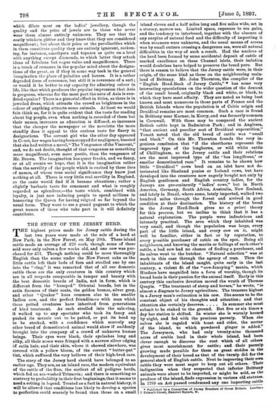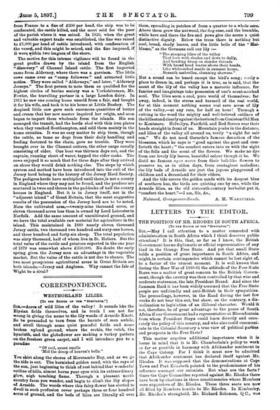THE STORY OF THE JERSEY HERD.
THE highest prices made for Jersey cattle during the last two years were made at the sale of a herd at New Park, in the New Forest, on May 20th. These island cattle made an average of £28 each, though some of those sold were only calves a few weeks old, and one cow was pur- chased for £51. Though nothing could be more thoroughly English than the scene under the New Forest oaks as the little cattle left their beds of fern and strolled one by one into the "ring," it was remarked that of all our domestic cattle these are the only creatures in this country which are in all respects comparable in temper and beauty with the best domestic breeds of India, not in form, which is different from the " humped " Oriental breeds, but in the satin fineness of their coats, the golden bronze, silver grey, and other " Quaker " hues common also to the smaller Indian cow, and the perfect friendliness with man which these petted creatures have inherited from generations of kind treatment. As each strolled into the sale-ring, it walked up to any spectator who took its fancy and pushed its muzzle out to be patted, or put its head up to be stroked, with a confidence which scarcely any other breed of domesticated animal would show if suddenly brought into the company of a crowd of unknown human beings. Their eyes were black, their eyelashes long and silky, all their noses were fringed with a narrow silver edging Of satin hair, and their skin, where it showed elsewhere, was covered with a yellow bloom, of the correct " butter-pat" tint, which suffused the very hollows of their high-bred ears.
The story of the Jersey herd should have belonged to an earlier age. They are, as an island race, the modern equivalent of the cattle of the San, the earliest of all pedigree herds, which fed on sea-washed Trinacria; and there is something so contrary to probability in their first beginnings, that it seems to need a setting in legend. Treated as a fact in natural history, it will be allowed that conditions less likely to develop a species to perfection could scarcely be found than those on a small
island eleven and a half miles long and five miles wide, set in a stormy, narrow sea. Limited space, exposure to sea gales, and the tendency to interbreed, together with the absence of any surplus of natural food and the difficulty of importing it when steamers were unknown, and the usual means of access was by small cutters crossing a dangerous sea, were all natural difficulties in the way of such a result. Had the nucleus of the herd been formed by some accidental deposit of cattle of marked excellence on these Channel islets, their isolation would doubtless have helped to preserve the breed pure. But there is reason to believe that the Jersey cattle were, in their origin, of the same kind as those on the neighbouring main- land of Brittany. Mr. John Thornton, the compiler of the " English Herd-Book of Jersey Cattle," * has some very interesting speculations on the wider question of the descent of the small breed, originally black and white, or black, to which they have most affinity. They are noted as being best known and most numerous in those parts of France and the British Islands where the population is of Celtic origin and Druidical remains are most common. Such a race is found in Brittany near Karnac, in Kerry, and was formerly common in Cornwall. With these may be compared the ancient British cattle kept in Badminton Park ; and in Anglesea, "that ancient and peculiar seat of Druidical superstition." Yonatt noted that the old breed of cattle was " small and black." On this Mr. Thornton founds the very in- genious conclusion that "if the shorthorns represent the improved type of the longhorns, or wild white cattle of Chillingham, so the Jersey cattle and their relations are the most improved type of the boa longifrons,' or smaller domesticated race." It remains to be shown how little " Druidical " cows bred on an islet have not de- teriorated like Shetland ponies or Iceland cows, but have developed into the creatures now eagerly bought not only by English gentlemen and English country ladies, for the Jerseys are pre-eminently " ladies' cows," but in North America, Germany, South Africa, Australia, New Zealand, and lately in Brazil, where some, lately imported, walked two hundred miles through the forest and arrived in good condition at their destination. The history of the breed in the Jersey Herd-Book gives no a priori theory for this process, but we incline to think that it has a natural explanation. The people were industrious and intensely practical. The area which they inhabited was very small, and though the population was large, every part of the little island, and every cow on it, might well be familiar, either in fact or by reputation, to every possible purchaser of cattle on the spot. Being all neighbours, and knowing the merits or failings of each other's cattle, a bad cow had no chance of finding a purchaser, and its calves went to the butcher. " Natural selection" was at work in this case through the agency of man. Then the inhabitants of the island caught, quite early in the last century, a violent fit of the "cow-fancying" mania, which Hindoos have magnified into a form of worship, though its broad basis is their passion for the animal itself. Early in this century this exclusive devotion moved the wrath of Thomas Quayle. "The treatment of sheep and horses," he wrote, "is almost a disgrace to Jersey agriculture. The treasure highest in a Jersey man's estimation is his cow. She seems to be the constant object of his thoughts and attention; and that
attention she certainly deserves In summer she must submit to be staked to the ground. But five or six times a day her station is shifted. In winter she is warmly housed by night, and fed with the precious parsnip. When she calves she is regaled with toast and cider, the nectar of the island, to which powdered ginger is added." The Jerseymeia, who had only twenty-nine thousand acres of arable land in their whole island, had been clever enough to discover the root which of all others gives most nourishment for cattle ; and -their parsnip growing made possible for them as great strides in the development of their breed as that of the turnip did for the general stock of English cattle. Next to improving their own cattle they were most eager to keep out all others. Their indignation when they suspected that inferior Brittany animals were about to be imported, or might be sold, as the produce of the island, finds expression in various old statutes. In 1789 an Act passed condemned any one importing cattle
• Published by a Committee of Jersey Breeders of Great Britain. Loudon: 7 Prince's Street, Hanover Square, W.
from France to a fine of £200 per head, the ship was to be confiscated, the cattle killed, and the meat sold for the poor of the parish where it was seized. In 1826, when the great and valuable export trade was established, the fine was raised to £1,000 per head of cattle introduced, with confiscation of the vessql, and this might be seized, and the fine imposed, if it were Tithin two leagues of the shore.
The motive for this intense vigilance will be found in the great profits drawn by the island from the English " diSoovery" of Channel Island cattle. The first imported came from Alderney, where there was a garrison. The little cows came over as "camp followers " and attracted little. notice. They were called " Alderneys," and later, " Alderney Jerseys." The first person to note them as qualified for the highest circles of bovine society was a Yorkshireman, Mr. Fowler, the travelling partner in a, large London dairy. In 1811 be saw one coming home unsold from a fair, and bought it for his wife, and took it to his home at Little Bushey. The despised little cow gave such enormous quantities of butter and cream that her new master inquired her origin, and soon began to import them wholesale from the islands. His son managed the transit, had the herds shod with thin iron plates when they reached Southampton, and sold them mainly in the home counties. It was no easy matter to ship them, though the cattle, as tame as dogs from their daily handling and feeding fastened to the chain, gave no trouble. They were brought over in the Channel cutters, the other cargo usually -consisting of cider. One boat was thirteen days out, and the -captain, running short of water, tapped the cider casks. The cows enjoyed it so much that for three days after they arrived on shore they would drink nothing else. The steps by which system and method have been introduced into the cult of the Jersey herd belong to the history of the Jersey Herd Society. The pedigree herds have multiplied until there.is not a county in England where they may not be found, and the produce are scattered in twos and threes in the paddocks of half the county houses in England. But it is in Jersey itself, not in the "adjacent island" of Great Britain, that the most suggestive results of the possession of the Jersey herd are to be noted. Note the cultivated area,—twenty-nine thousand acres, or eleven thousand acres less than is owned by Lord Leicesterin Norfolk. Add the same amount of uncultivated ground, and we have the total available raw material for agriculture in the island. This maintained in 1880 nearly eleven thousand Jersey cattle, two thousand two hundred and sixty-one horses, and three hundred and forty-six sheep. The total population was sixty thousand, half of whom live in St. Heliers. But the total value of the cattle and potatoes exported in the one year of 1879 was somewhat above £30,000. No doubt the early spring gives the Jersey men an advantage in the vegetable market. But the value of the cattle is not due to chance. The two most prosperous agricultural areas in Great Britain are both islands,—Jersey and Anglesea. Why cannot the Isle of Wight be a rival ?







































 Previous page
Previous page